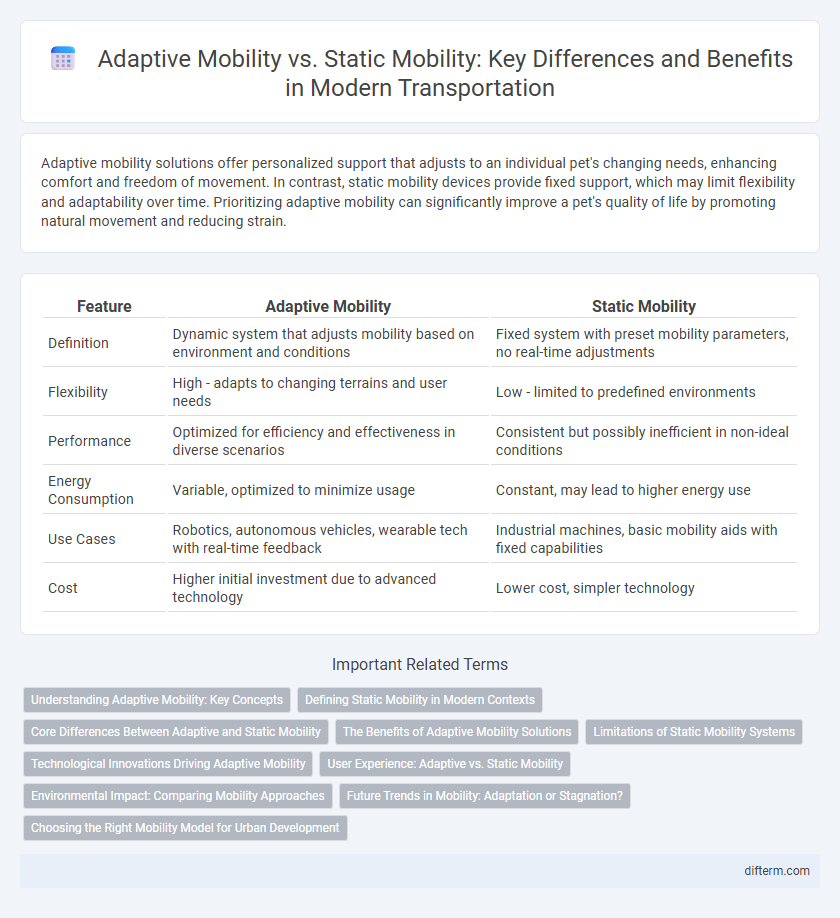Adaptive mobility solutions offer personalized support that adjusts to an individual pet's changing needs, enhancing comfort and freedom of movement. In contrast, static mobility devices provide fixed support, which may limit flexibility and adaptability over time. Prioritizing adaptive mobility can significantly improve a pet's quality of life by promoting natural movement and reducing strain.
Table of Comparison
| Feature | Adaptive Mobility | Static Mobility |
|---|---|---|
| Definition | Dynamic system that adjusts mobility based on environment and conditions | Fixed system with preset mobility parameters, no real-time adjustments |
| Flexibility | High - adapts to changing terrains and user needs | Low - limited to predefined environments |
| Performance | Optimized for efficiency and effectiveness in diverse scenarios | Consistent but possibly inefficient in non-ideal conditions |
| Energy Consumption | Variable, optimized to minimize usage | Constant, may lead to higher energy use |
| Use Cases | Robotics, autonomous vehicles, wearable tech with real-time feedback | Industrial machines, basic mobility aids with fixed capabilities |
| Cost | Higher initial investment due to advanced technology | Lower cost, simpler technology |
Understanding Adaptive Mobility: Key Concepts
Adaptive mobility enhances user experience by dynamically adjusting to environmental changes and individual needs, unlike static mobility which relies on fixed paths and schedules. Key concepts include real-time data integration, machine learning algorithms, and sensor-based feedback systems that optimize route planning and vehicle operation. This approach supports flexible transportation solutions, reduces congestion, and improves accessibility for diverse populations.
Defining Static Mobility in Modern Contexts
Static mobility refers to limited or fixed movement patterns within defined spatial or temporal boundaries, often characterized by reliance on traditional or immobile transportation modes. In modern contexts, static mobility impacts urban design by reinforcing dependency on stationary infrastructures such as parking lots and fixed transit routes. Understanding static mobility is critical for developing flexible transportation systems that address evolving demands for accessibility and efficiency.
Core Differences Between Adaptive and Static Mobility
Adaptive mobility involves dynamic adjustments to movement patterns based on real-time environmental feedback, enhancing flexibility and responsiveness in various terrains. Static mobility relies on fixed movement strategies optimized for consistent, predictable conditions, limiting adaptability but often providing stability. Core differences center on responsiveness to change, with adaptive mobility prioritizing real-time adjustments and static mobility emphasizing consistent control.
The Benefits of Adaptive Mobility Solutions
Adaptive mobility solutions enhance user independence by automatically adjusting to varying terrain and environmental conditions, ensuring seamless navigation and safety. These systems integrate real-time sensor data and machine learning algorithms to provide personalized support, optimizing comfort and energy efficiency. Increased accessibility and reduced physical strain contribute to improved quality of life for individuals with mobility challenges.
Limitations of Static Mobility Systems
Static mobility systems are constrained by fixed infrastructure, limiting flexibility and adaptability in dynamic environments. These systems often struggle with accessibility issues, especially in unpredictable or changing terrains. Their inability to respond to real-time conditions reduces efficiency and user experience compared to adaptive mobility solutions.
Technological Innovations Driving Adaptive Mobility
Technological innovations driving adaptive mobility include advanced sensor systems, AI-powered navigation, and real-time data analytics that enable vehicles to dynamically adjust to changing environmental and user conditions. Unlike static mobility models with fixed routes and predefined schedules, adaptive mobility leverages IoT connectivity and machine learning algorithms to optimize route planning, traffic management, and personalized transport services. This integration of smart technology enhances efficiency, reduces congestion, and increases accessibility in modern transportation networks.
User Experience: Adaptive vs. Static Mobility
Adaptive mobility enhances user experience by dynamically adjusting transportation options based on real-time data such as traffic conditions, user preferences, and environmental factors. Static mobility, in contrast, relies on fixed routes and schedules, often resulting in inefficiencies and reduced flexibility for users. Integrating adaptive mobility systems improves accessibility, reduces travel time, and offers personalized solutions that static mobility cannot provide.
Environmental Impact: Comparing Mobility Approaches
Adaptive mobility systems reduce environmental impact by optimizing routes and transportation modes based on real-time data, leading to lower emissions and decreased energy consumption compared to static mobility models that rely on fixed routes and schedules. Static mobility often results in higher carbon footprints due to inefficient vehicle utilization and increased congestion. Embracing adaptive mobility enhances urban air quality and supports sustainable transportation infrastructure development.
Future Trends in Mobility: Adaptation or Stagnation?
Future trends in mobility emphasize adaptive mobility systems that leverage real-time data, AI-driven optimization, and flexible infrastructure to enhance efficiency and user experience. Static mobility models, reliant on fixed routes and schedules, face limitations in addressing dynamic urban demands and environmental challenges. Embracing adaptive mobility technologies fosters sustainable, resilient transportation networks capable of evolving with shifting demographic and technological landscapes.
Choosing the Right Mobility Model for Urban Development
Adaptive mobility models prioritize real-time data and environmental responsiveness to optimize urban transportation systems, enhancing flexibility in route planning and congestion management. Static mobility models rely on fixed infrastructure and pre-determined routes, offering stability but lacking responsiveness to dynamic urban conditions. Selecting the appropriate model involves evaluating the city's technological readiness, population density, and specific mobility challenges to ensure sustainable and efficient urban development.
adaptive mobility vs static mobility Infographic

 difterm.com
difterm.com